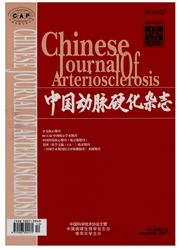

 中文摘要:
中文摘要:
目的探讨大鼠颈动脉球囊损伤后粒细胞集落刺激因子动员对损伤血管内膜增殖和内皮修复的影响及其相关机制。方法36只雄性Wistar大鼠随机分为假手术组(n=12)、损伤+细胞因子组(n=12)和损伤+安慰剂组(n=12)。损伤+细胞因子组在球囊损伤后即刻腹腔注射粒细胞集落刺激因子[100μg(k·d)]直至术后2周,损伤+安慰剂组给予等量生理盐水注射,术后2周取血管段HE染色计算内膜/中膜面积比,免疫组织化学观察并计算增殖细胞核抗原阳性细胞比例,通过伊文氏蓝染色计算内皮修复率,血管匀浆检测一氧化氮释放量,用流式细胞术检测外周血CD34^+VEGFR-2^+双阳性细胞比例。结果与假手术组比较,损伤+安慰剂组血管内膜增殖明显,有较多增殖细胞核抗原阳性细胞,内皮修复不全,血管匀浆中一氧化氮释放量减少;与损伤+安慰剂组相比,损伤+细胞因子组内膜/中膜面积比和增殖细胞核抗原阳性细胞比例降低(分别为1.04±0.05比1.67±0.07和21.3%±5.1%比34.4%±6.1%,P〈0.05),内皮修复率和一氧化氮释放量增加(分别为70.1%±4.6%比53.2%±3.8%和71.3±12.9μmol/L比56.7±10.8μmol/L,P〈0.05);损伤+细胞因子组外周血CD34^+VEGFR-2^+双阳性细胞比例较损伤+安慰剂组明显上升(0.954%±0.076%比0.379%±0.052%,P〈0.05)。结论粒细胞集落刺激因子明显增强血管损伤后内皮修复并减轻新生内膜增生,其机制可能涉及骨髓动员增加外周血内皮祖细胞比例。
 英文摘要:
英文摘要:
Aim To investgate the effect of granulocyte colony-stimulating factor (G-CSF) on reendothelialization and neointimal hyperplasia in balloon injured carotid of rat, and explore its potential mechanism. Methods 36 Wistar rats were randomly divided into three groups: sham operation group ( n = 12), G-CSF group ( n = 12) and placebo group ( n = 12). The balloon-injured carotid model was established in G-CSF group and placebo group, G-CSF [ 100μg/(kg· d) ] was intraperitoneal injected in G-CSF group from the point at operation to 2 weeks after operation, saline was administrated in placebo group. After two weeks, the neointima/media area ratio (IA/MA), repair rate of injuried endothelium, the proliferating cell nuclear antigen (PCNA) positive cell ratio and nitric oxide (NO) release in vessel homogenate were detected in three groups. In addition, the ratio of CD34^+ VEGFR-2^+ double positive cell was detected by FACS. Results Compared with the placebo group, the IA/ MA and PCNA positive cell ratio were reduced ( 1.04 ± 0.05 vs 1.67 ± 0.07, 21.3 % ± 5.1% vs 34.4 % ± 6.1%, respectively, P 〈 0.05 ) ; repair rate of injuried endothelium and NO release increased (70.1% ± 4.6 % vs 53.2 % ± 3.8 %, 71.3 ± 12.9μmol/L vs 56.7+10.8μmol/L, P〈0.05) in G-CSF group. The ratio of CD34^+ VEGFR-2^+ double positive cell of G- CSF group was higher than that of placebo group (0.954 % ± 0. 076 % vs 0. 379% ± 0. 052 %, P 〈 0. 05 ) The results suggested that G-CSF may increase the ratio of EPC in peripheral blood by mobilizing the bone marrow, then improve the effect of repair rate of injuried endothelium and inhibit neointimal hyperplasia.
 同期刊论文项目
同期刊论文项目
 同项目期刊论文
同项目期刊论文
 期刊信息
期刊信息
